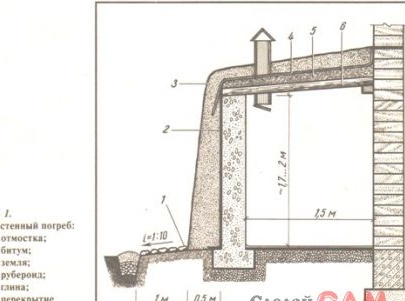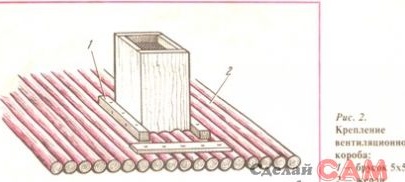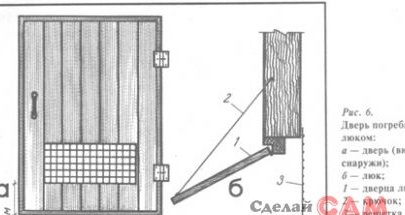Today many cannot afford to build a large four-walled brick country cellar for storing potatoes, vegetables, various preparations for the winter. And it is not safe to place it at some distance from the country house. They steal, you know ... Therefore, it is most reliable to make a small cellar adjacent to one of the walls of a country house (Fig. 1). Moreover, scarce and expensive building materials are not needed here, since it is quite possible to do with the most affordable ones available at hand for the construction of the cellar.
The walls of the cellar, for example, in the absence of red brick, are made monolithic using sand-cement mortar. The wall thickness is 20 ... 25 cm and the height is 1.7 ... 2 m.
Having dug a pit with a depth of 0.5 ... 0.7 m (no deeper than the level of groundwater), formwork is collected from old boards and panels for pouring. To prevent it from bursting when laying the mortar, the formwork walls are strengthened with wire twists, supports, etc. Everything is suitable as concrete aggregate: brick fight, cobblestone, pieces of reinforcement, scrap metal, broken glass and even empty bottles that are placed along the future wall so that they do not protrude when removing the formwork. The lower part of the wall (base of the cellar) can be made wider (see Fig. 1). Do not forget to make a pillow of compacted gravel under the base of the wall.
High-quality concrete is obtained when the amount of gravel or gravel in it does not exceed more than twice the amount of sand. With a minimum consumption of cement (grades “300” and “400”), the optimal mix ratio for pouring is 1: 1: 2 (cement: sand: crushed stone). The pouring is carried out in stages, for example, first they form the wall of the cellar 1 m high, carefully compact the concrete and give it two days of exposure for solidification (in dry weather, concrete is poured with water).
And these two days you will be occupied with the device of the cellar floor. If there is cement, then first a concrete base 10 cm thick is laid for the cellar floor (again on a gravel cushion), and then a cement screed 5 cm thick is formed. But the cellar floor will be cheaper and no worse than a mixture of clay and coarse sand, in which is additionally tamped with cobble stone. Then carefully covering all the formed seams and irregularities with crumpled clay, we get a strong and comfortable floor for the land cellar, which is also a reliable protection against groundwater.
After the solidification of the concrete in the formwork, the latter is transferred higher and the erection of the walls is completed.
The ceiling of the cellar is usually made of a thick slab or suitable sanded poles, the gaps between which are clogged with a layer of crumpled clay. But before embarking on clay in the ceiling of the cellar, a ventilation duct is installed from tightly knocked down boards 3 ... 4 cm thick (Fig. 2). At the bottom of the hinges, a lid is mounted to close the box in winter time (Fig. 3).
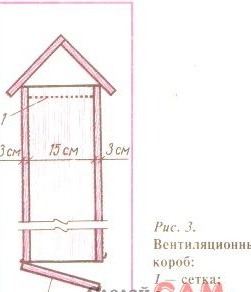 A fine mesh or a tin with drilled holes (about 1 cm in diameter) is installed in the upper part of the box to protect the cellar from entering rats and mice through the ventilation. For the same purpose, an old disassembled oil filter from any heavy tractor is suitable. On top of the box provide a visor from two boards, like a roof.
A fine mesh or a tin with drilled holes (about 1 cm in diameter) is installed in the upper part of the box to protect the cellar from entering rats and mice through the ventilation. For the same purpose, an old disassembled oil filter from any heavy tractor is suitable. On top of the box provide a visor from two boards, like a roof.To prevent rotting of wooden parts in contact with the ground, they are impregnated with hot linseed oil or lightly charred with a blowtorch. They say that wood protects the wood well by impregnating it with any old engine oil (“working out”), which is always abundant in any the garage and which, besides the pollution of soil and water, has not yet found worthy application.
The ventilation of the cellar is conveniently made from a pipe (plastic or asbestos) of a suitable size. The exhaust hood comes out of the finished pipe more authentically, but the draft increases with the height of the exhaust pipe. Fasten the pipe to the ceiling as follows. Drill in an asbestos pipe, and burn through a red-hot wire in a polyethylene pipe, in the opposite walls opposite each other through a hole with a diameter of 1.5 ... 2 cm, into which before installing the pipe on the cover, pieces of reinforcement with a thickness corresponding to the diameter of the holes and a length of 50 cm are passed. The ends of the reinforcement, mounted on the ceiling, will become a support for the ventilation pipe of the cellar (Fig. 4). In the same way, it is not forbidden to install a wooden box. By the way, the fittings passed through the pipe in the spring-summer-autumn time are convenient to use for hanging on hooks home sausages, ham, meatloaf, fish, ham for ventilation in a draft, for which you will have to open a special hatch in the door. Recall that this method of keeping products in a draft for one ... two months is usually carried out before smoking.
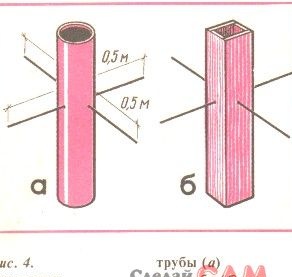
To protect from rain and snow, a tin clamp equipped with two racks to which they are riveted is put on the upper end of the ventilation pipe
a tin can (from the "iwashi" or "herring") of a suitable size (Fig. 5).
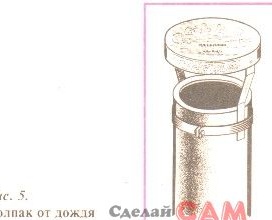
Doors the cellars are made of solid planks 4 cm thick. A hatch is installed on the hinges at the bottom of the cellar door, while the hole for the hatch is closed by a lattice with a small cell (1x1 cm), again from rodents. For the winter, the lattice is covered with a padded jacket, blanket, polystyrene foam, paper, which are pressed to the lattice by a lowered hatch. In the warm season, air enters the cellar through the hatch, providing forced ventilation (Fig. 6).
Now a little about the insulation of the walls and roof of the cellar. First, the walls of the cellar on the outside are smeared twice with hot bitumen (for waterproofing the cellar), and a layer of crumpled clay with a thickness of 15 cm is applied to the ceiling for the same purpose, after which roofing material (two layers) is laid on the clay.
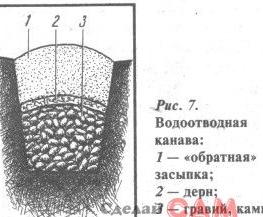 When working with hot bitumen (they are conducted only in dry, clear weather!) Pay special attention to safety precautions. Covering the walls with molten bitumen, you should wear a suit and mittens made of dense material, nearby must be dry sand and a shovel.
When working with hot bitumen (they are conducted only in dry, clear weather!) Pay special attention to safety precautions. Covering the walls with molten bitumen, you should wear a suit and mittens made of dense material, nearby must be dry sand and a shovel.Having finished with bitumen, they fill the top and walls of the cellar with earth or peat (layer thickness 50 cm) and sow grass. Perennial grass is best suited here - a field breeze that does not require mowing (it serves to close the lawn, lawns, forming a thick beautiful turf).
It remains to arrange around the walls of the cellar with a cobblestone pavement along a layer of clay.The width of the blind area is about 1 m, it is constructed with a slope in the drainage groove (the depth of the last 0.5 m), half filled with drainage materials: crushed stone, brick fight, glass (Fig. 7).
The potatoes are stored in a trellised crate, raised 10 cm from the floor, carrots and beets - on the cellar floor. For cans with pickles, canned and pickled products, compotes, wooden racks are arranged on the walls.
Once a year, the cellar should be cleaned, ventilated and disinfected. When disinfecting the walls, the ceiling and racks of the cellar are bleached with lime (1 bucket of lime dough for 5 buckets of water) with the addition of 1 kg of copper or iron sulfate. It is clear that the disinfection of the cellar is carried out in the summer when there are no products there.
Wiring the cellar is made externally from a cable with double insulation or a wire with copper conductors in polyethylene pipes mounted on brackets.
Sockets in the cellar are not allowed, the lamps are only sealed, the switches are mounted outside, protecting from rain and snow with a rubber apron.

